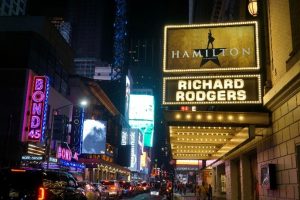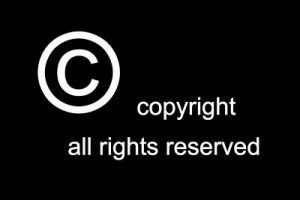When I was in high school, the annual musical was always a big deal. They would do renditions of famous productions such as Fiddler on the Roof, The Sound of Music, and even Disney’s High School Musical. Although I had long since graduated from high school by the time my favorite musical Hamilton became popular, I noticed that there weren’t really productions of it outside of Broadway sponsored productions. Perhaps a recent controversy regarding the threat of a copyright lawsuit and an unauthorized Hamilton production at a Texas church helps explain why…

Photo by Sudan Ouyang, licensed by Unsplash
In early August, a Texas church made news for an unauthorized performance of Hamilton. The church performance, however, altered song lyrics and added anti-LGBTQ language. Hamilton creator, Lin-Manuel Miranda, threatened legal action. Ultimately, he granted the church permission to perform the show one last time. In an apology letter, the church also agreed to destroy any recording of the performance and pay an unspecified amount to avoid liability. This made me interested in learning more about how copyrights work with musicals and some of these “way-off” Broadway productions.
What is copyrightable work? And what exactly would someone get out of it?
US Copyright Law states that copyrights can exist in any original work of authorship that is fixed in a tangible medium. What does that mean? Well, anything you write, sing, or design which is fixed in a permanent medium, like in sheet music for example, can be copyrighted. That is, as long as it is original to you and has some degree of creativity.
Owners of copyrights have certain exclusive rights that are listed in Section 106 of the Copyright Act. These include the right to reproduce or copy the work, to make a derivative work, and to distribute the work to the public.
Copyright owners for things like musicals such as Hamilton also have the right to public display and/or performance. Public display is the right to show something to the public, for example, by displaying the Hamilton script in a museum. The right to public performance would be showing the Hamilton film in a movie theater to the general public.
Having these rights means that copyright owners can give others a license if they want to allow them to use their work in a certain way. This is how most schools, theater companies, and other off-Broadway productions are able to perform famous musicals – by asking for or purchasing a license!

Image by Mike Seyfang, licensed by Flickr
So how do we get to copyright infringement? And how might someone get out of it?
The first thing to note regarding copyright infringement is that you can’t be sued unless the original owner registered their copyright with the Library of Congress. However, you can register right before filing a lawsuit, so this isn’t much of a barrier.
Second, the infringer must have access to the original work. So, if someone can prove that they had no idea Hamilton existed but performed something identical, there is no infringement.
Finally, there must be improper appropriation, which means the defendant has copied so much of the original and creative elements of the copyrighted work that both are substantially similar. For example, if someone copies a Broadway show without permission, it’s likely substantially similar and therefore improper appropriation.
So, does this mean anyone who copies or performs a registered and copyrighted musical without permission is liable for copyright infringement? Not always – especially if they can demonstrate “Fair use” during litigation. This is a defense to copyright infringement which would allow someone to use copyrighted material without permission depending on evaluation of all the “fair use factors”.
Purpose and Character of Defendant’s Use
The first fair use factor is the purpose and character of the defendant’s use. This allows parties to use a copyrighted work without permission for purposes such as criticism, comment, news reporting, or research, depending on balance with other factors. But if you have a similar purpose to the original copyrighted work, like commercial entertainment for a musical, this factor probably won’t favor fair use. For example, if the church sold tickets to their musical based on Hamilton which used substantially similar characters, songs, and plot, this probably does not favor fair use,
However, a defendant could get around this if they have a transformative work or use. A transformative work is one where the old work is used in a completely new or unexpected way. For example, a Hamilton themed civil procedure hypo is likely completely new and unexpected enough to be transformative work. Transformative use is borrowing an old work but adding a new meaning and message. The church may have a transformative use by making a more religious version. However, they only changed a few words so this likely isn’t enough to be a transformative use and likely won’t be considered fair use.
Nature of Plaintiff’s Work
The second fair use factor is the nature of plaintiff’s work. For this factor, a judge will typically consider whether the original work is factual or entertaining and highly creative in nature. If an original work is mostly factual, this likely favors fair use but if something is very creative then any copying is likely not. Hamilton is based on factual information, but the songs are likely seen as highly creative and entertaining. So, when the church use
s its highly creative songs and only changes a few lyrics, this likely does not favor fair use.
Amount and Substantiality of Plaintiff’s Work Used
The third fair use factor is the amount and substantiality of the plaintiff’s work used by the defendant. This generally doesn’t favor fair use if the amount taken is quantitatively significant or if only a small amount, the essential meaning or “heart” of the work. For example, the church took almost the entirety of the Hamilton musical, including the iconic rap songs about historical events. The only difference is that they changed some of the lyrics. Therefore, the church’s use of similar style of songs with almost identical lyrics definitely doesn’t favor fair use, especially when they did not have permission.
Market Effects
Finally, the last fair use factor is the effect of the defendant’s use on the actual and potential market. This depends on whether the copied use undermines the original copyright owner’s profits or ability to profit from their work, even if not in direct competition. Say the church charged a price for a ticket but didn’t give any of the profits to the original Hamilton creators. This would negatively impact the original creators’ ability to profit from derivatives of Hamilton and likely not favor fair use.
Overall, none of these factors really point in favor of fair use for the church production of Hamilton so they probably don’t have a good defense to copyright infringement.

So, can I perform Hamilton?
While no lawsuit was ever filed against the church, that’s likely because they stuck to just one performance per the license. Given the fair use factors, it seems like it would be pretty difficult to perform a modified version of Hamilton, or any other copyrighted musical for that matter, without permission from the copyright owner.
One way to get permission is by paying for a license to perform the show from the associated copyright owners. In fact, Lin-Manuel Miranda actually exercised this by asking and subsequently obtaining permission to use certain musical compositions for Hamilton that were originally created by others. In other words, he obtained a license.
But maybe small theater productions don’t have lots of money to spend on licenses to perform musicals that are currently popular like Hamilton. Perhaps Hamilton creators don’t want to give up their profits from that popularity by providing licenses either. So, I wouldn’t be shocked if we don’t see any “way-off” Broadway version of Hamilton unless that profitable popularity ever goes away.

Maddie Domenichella
Associate Blogger
Loyola University Chicago School of Law, J.D. 2024
